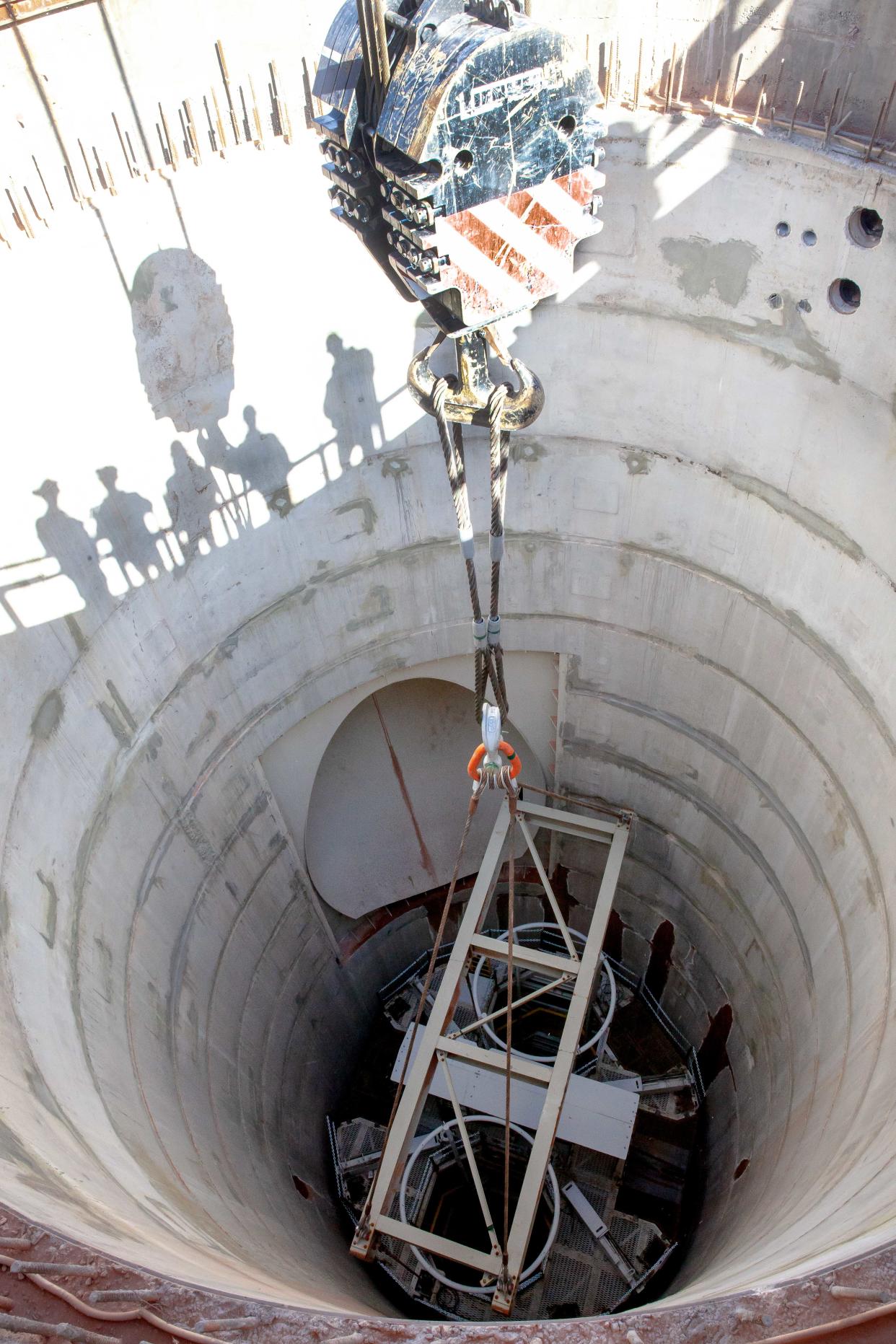$15M elevator repairs at Waste Isolation Pilot Plant nuclear repository starting in July
A $15 million project to rebuild part of an elevator at the Waste Isolation Pilot Plant used to move mined salt out of the underground was planned for July and expected to be completed by October, federal officials said.
Known as the “salt pocket,” the area being repaired is used to stage the salt as it is brought to the elevator, and then lifted to the surface via the hoist. That’s important because WIPP is underway with mining one of two panels needed for waste disposal approved in a recent permit renewal, making up space lost at the repository to contamination in a 2014 incident that led to a suspension of waste disposal for three years.
The waste is brought into WIPP about 30 miles east of Carlsbad from Department of Energy sites throughout the U.S. and buried in the underground salt deposit about 2,000 feet beneath the surface.
Without the salt pocket, mined salt can be stored temporarily in the access drifts of the WIPP underground, read a DOE news release, but officials said it was “preferred” to send it directly to the surface.
The work is part of a series of facility-wide infrastructure upgrades as the site eclipses its 25th year of operations. WIPP is also rebuilding its ventilation system to the tune of about $470 million, along with a $100 million air intake shaft on the western side of the mine where the new panels are going. The shaft will likely also have hoisting capabilities and could be used to move salt from the underground as the two panels and potentially more are being constructed in the underground.
More: A nuclear reactor in Carlsbad? Local leaders call for atomic energy at repository site
Work to address long-standing problem at WIPP
Problems with the salt pocket were first noted by the Defense Nuclear Facilities Safety Board in its January monthly report, reflecting incidents and safety concerns at WIPP during December 2023. In that report, the Board noted “temporary” measures were taken to reinforce the shaft and pocket’s structural steel over the years, but ongoing salt creep increased lithostatic pressure and necessitated a long-term solution. The DOE reported the salt gradually collapses, causing the pressure, about 2 to 6 inches a year.
In its February report, the Board reported the shaft was temporarily taken out of service while such a resolution was devised, and noted funding was acquired for the project in the March report.
“The Salt Handling Shaft continues to be the subject of ongoing federal and contractor evaluations regarding its structural condition and efforts required to maintain safety and operational capabilities,” read the Board’s January report.
The Board reported the concerns with the salt shaft were due to gradual, natural deformation of the salt in the mine putting pressure on the structure, in its December report, reducing the clearance for carts delivering salt to the pocket.
“As the salt seam deformed over time below the shaft station, loads increased on the structural steel reinforcing the lower part of the shaft, causing some steel members to fail,” that report read.
DOE Carlsbad Field Office Manager Mark Bollinger said repairing the pocket would increase mining efficiency, and that work to fix it was underway.
“The salt pocket is critical to our continued success as we safely dispose of the nation’s defense-related transuranic waste,” Bollinger said in a statement. “Investing in this project will ensure we maintain our capability to efficiently stage mined salt until it’s ready to be removed from the underground repository.”
More: Los Alamos decontaminating nuclear waste. Could it save space at repository near Carlsbad?
WIPP works to improve utility shaft operations, fixes in air system
Oversight officials reviewed corrective actions taken at the utility shaft project, after several incidents were reported earlier this year and work stop was ordered Feb. 8, according to the latest report by the Defense Nuclear Facilities Safety Board.
Subcontractor Harrison Western Shaft Sinkers retained a “safety culture expert,” the report read, the review the ongoing work monthly to prevent any future accidents. Previous incidents included a cable connected to a material handling basket snapping and dropping the basket to the bottom of the shaft, records show, and a rigging wire to breaking on a tugging device connected to a skid steer loader vehicle.

In October, the Board also reported another skid steer loader vehicle swung uncontrollably and struck the shaft’s scaffolding platform known as the Galloway. No one was injured in any of the three incidents.
Additional corrective actions were also underway at the ongoing ventilation system project, the Board reported, after a fire a flush of the system’s fire suppression system, causing a hydrant to “dislodge into the air,” an incident the Board said was likely caused by “improper installation methods.”
Adrian Hedden can be reached at 575-628-5516, achedden@currentargus.com or @AdrianHedden on the social media platform X.
This article originally appeared on Carlsbad Current-Argus: Feds to spend $15M in lift repairs at nuclear repository near Carlsbad
